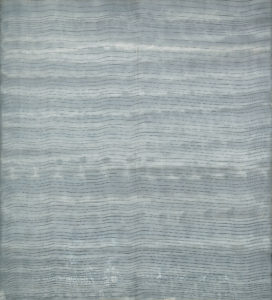Biography
Jean Degottex
1918-1988
Jean Degottex (1918-1988) is a French abstract painter, whose prolific artistic work spans nearly fifty years.
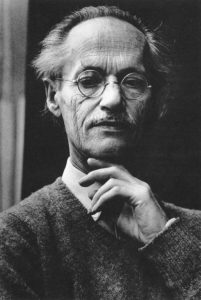
Photography by Alice Springs.
Born in Sathonay-Camp on February 25, 1918 in a modest home, Jean Degottex spent his childhood in Lyon. At the age of fifteen, he moves to Paris with his parents, quits school and begins to earn a living. He becomes involved in libertarian circles and participates in drawing and painting workshops in liberal academic institutions, including the liberal Academy of the Grande Chaumière. In Tunisia, where he completes his military service, then in Algeria, from 1939 to 1941, he paints his first figurative paintings, inspired by the Fauvist artists.
He decides to devote himself entirely to painting. From 1941, he participates in the Salon des moins de Trente Ans. In 1946, he marries Marie-Rose (Mirose) Patrix, the sister of Michel Patrix, artist heavily associated with La Grande Chaumière, and in February 1947 is born their daughter Frédérique.
From 1948, he turns specifically towards abstract art. From then on, the gestural painting style begins to unfold. The works of this period then brings Jean Degottex closer to lyrical abstraction, a major current at the time.
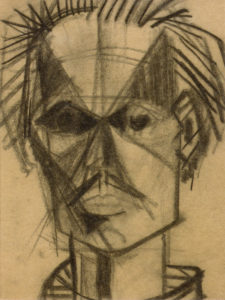
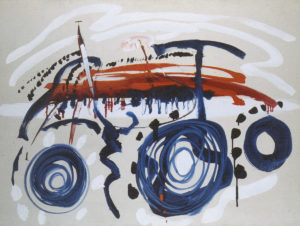
In 1949, he exhibits for the first time at the Denise René Gallery, who supports the artists of the avant-garde abstract movement, and then at the Beaune Gallery. That same year, he befriends Renée Beslon, poet, visual artist and art critic, who will remain his companion until his death. He is awarded the Kandinsky Prize in 1951.
In Saint-Léonard-en-Beauce, then in Brittany, and in Portsall, in 1953 and in 1954, his works still appear as free interpretations of nature, but from 1954, Jean Degottex moves towards a gestural abstraction, which is more radical.
In 1955, he joins the Kleber Gallery, under the direction of Jean Fournier. He encounters complex times with Simon Hantaï and Georges Mathieu. He becomes close friends with the poet Bernard Heidsieck, with the painters Françoise Janicot, Jean Dupuy and the sculptor Paul Armand Gette. In 1959, he joins the International Gallery of Contemporary Art, under the direction of Maurice d’Arquian.

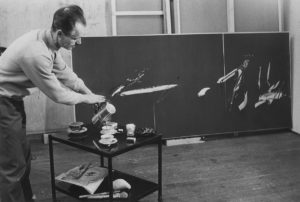
The period from 1956 to 1963 is particularly fruitful. He often paints large-scale works, often in series, digging the same idea until it is exhausted: suite Ashkenazi (1957), suite Serto (March-April, November 1957), suite des Hagakure (November 1957), les 18 Vides (1959), suite des Roses (1960), suite des Alliances (1960), les 7 Metasignes (1961), Jshet (1962). The gesture bears fruit after a long meditation, and is thrown in an “instantaneous” manner on a background that has long been prepared.
His daughter Frédérique passes away in a freak accident at the age of 16. After a year of hopelessness and idleness, Degottex resumes his series des Écritures. These include the following: the suites Rose-Noire (August 1964), Suite Obscure (November-December 1964), Metasphère (1966), ETC (December 1964 / March 1967) and Horsphères (1967). From 1966 until his death, he produces a wider collection of work in Gordes, in the Vaucluse region.

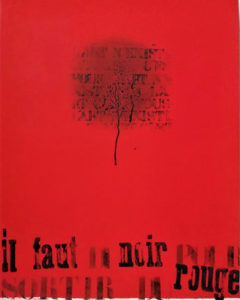
He is involved in the graphic design movement active in May 68. In 1969, he works with architect Jean Daladier to design houses in form of domes in the Saint-Julien-du-Sault region. They exhibit together at the City of Paris Museum of Modern Art.
From 1972 to 1976, he mounts several solo exhibitions at the Germain Gallery. He joins the writer Bernard Lamarche-Vadel and exhibits, once again at Jean Fournier, his Séries des Médias. He works more and more with paper material: the tearing technique for example revealing this texture (seriés d’ARR rouges, puis blancs). The Germain Gallery also exhibits his Papiers Pleins (1974-1975), papers glued and peeled in horizontal stripes, and his Papiers pleins Obliques (1976) with incisions raised by diagonals.
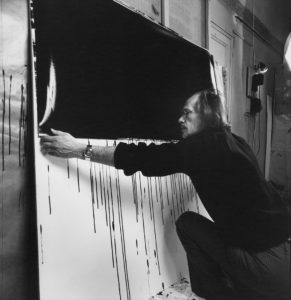
Photography: Michel Nahmias
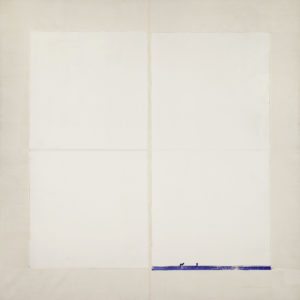
205 x 203 cm, acrylic on canvas
With the Papiers-Report (1977), he begins to explore a new technique that involves “reporter” by folding half of the paper surface onto the other. He uses this imprint technique on all sorts of materials, including large acrylic canvases: the séries des Lignes-Report (1978) and the Plis-Report (1978).
In 1979, he creates specificially for a solo exhibition at the Abbaye de Sénaque at Gordes, a series of paintings referred to as Déplis, including many major Déplis-Bleu.
In 1981 he is awarded the Grand National Prize of Painting (Grand Prix National de la Peinture)
In 1982, he joins the Gallery of France, which Catherine Thieck had once again taken over the direction, and creates the series of the Grilles-Collors, the Oblicollors, the Diacollors. His last major works are the Lignes-Bois (1985) and the Contre-Lignes Bois (1986), in white, grey, or blue grey.
Jean Degottex is deceased in Paris on December 9, 1988.
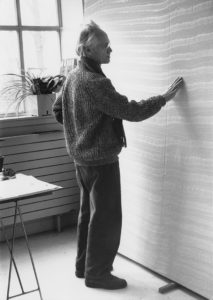
photographie: Françoise Janicot, 1985
